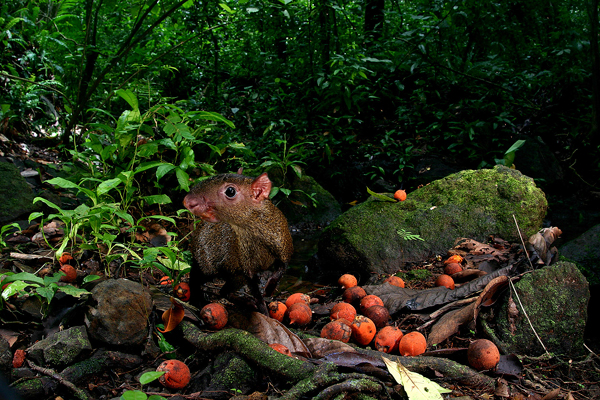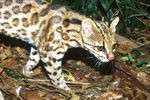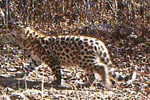Scientists discover clear temporal patterns between the ocelot and its agouti prey.
The early bird might get the worm, but, as scientists have discovered, the bird is also quite likely to become a cat’s meal.
In a study recently published in the online Animal Behavior journal, scientists from the US and the Netherlands have examined the impact of predation patterns on prey’s food foraging habits. The two-year long study on Barro Colorado Island, Panama, focused on the predator-prey relationship between the Central American agouti (Dasyprocta punctata), a common rainforest rodent, and the ocelot (Leopardus pardalis).
Agoutis, which look like long-legged guinea pigs, are a common prey item for the ocelot, a medium-sized cat native to the Neotropics.
 Agouti eating palm seeds. Photo credit: Christian Ziegler.
Agouti eating palm seeds. Photo credit: Christian Ziegler.
“The ocelot-agouti relationship is a beautiful example of a predator-prey interaction,” Patrick Jansen, a researcher with the study, told mongabay.com. “This example was easy to study on Barro Colorado Island, where both species are relatively common.”
Jansen’s study was the first to look at the temporal pattern of ocelot predation and the long-term food supply of its prey, the agouti. In plainer terms, every time an agouti goes out to forge, it does a risk-benefit analysis. Is it better to stay in its den and be hungry, or get food and risk becoming cat food? As it turns out, the answer is heavily dependent on what time the agouti goes out.
The team utilized modern technology for reliable data. “We used radio-collars mounted on agoutis to follow their whereabouts and fate, an automated telemetry system to continuously ‘listen’ to radio signals, and camera traps to record activity patterns of ocelots and agoutis, as well as the use of burrows by agoutis,” Jansen explained.
In all, the study collard 36 agoutis and used camera traps in 1,371 different locations over 11,123 days, as well as monitoring local food abundance by counting the local number of Astrocaryum fruits, a common agouti food. Throughout the study, scientists looked at the activity ratio between agoutis and ocelots and the ratio between fruit and agoutis to see if there was a temporal, or time-based, pattern.
 Ocelots hunt at night. Agoutis look for food during the day. Hungry agoutis may extend their foraging times and are more likely to be eaten. Photo courtesy of Christian Ziegler. |
The scientists found that agoutis and ocelots’ activity peaks do not overlap: 94.5% of the agoutis’ activity takes place during daylight hours, while 77.8% of ocelot’s takes place between sunset and sunrise. The agouti’s and ocelot’s night and daytime ratios are polar opposites. In fact, during sunlight hours, the study discovered that there is one ocelot for every 500 agoutis. At nighttime, there are 30 ocelots for every one agouti.
Jansen says, “Overall hunting success of ocelots (the amount of captures per unit effort spent) will probably be higher during the night, where cats with their night vision are at an advantage.”
In fact, 62.5% of the collared agoutis’ deaths took place at night, what the study refers to as a “high-risk period,” since it’s the ocelot’s peak activity hours. So if you’re an agouti, staying in at night is probably a good idea, if you can afford to.
“Agoutis that had more fruit trees in their home range got up later in the morning and went back into their burrows earlier in the evening,” explained Jansen. The more food an agouti has access to, the fewer risks it needs to take to stay full. The empirical data the team collected could prove this long-established theory that preys’ foraging behavior is dependent on predators’ movements.
“We cannot tell from our study whether the theory applies to other predator-prey system as well as it applied to ocelots and agoutis,” Jansen told mongabay.com, “but it would not surprise me. These responses would perfectly make sense for any prey species.”
You can read the team’s blog and watch camera trap videos at The Agouti Enterprise.
Citations:
- Lennart Suselbeek, Willem-Jan Emsens, Ben T. Hirsch, Roland Kays, J. Marcus Rowcliffe, Veronica Zamora-Gutierrez, Patrick A. Jansen. Food acquisition and predator avoidance in a Neotropical rodent. Animal Behaviour, Volume 88, February 2014, Pages 41–48
- Ricardo S. Moreno, Roland W. Kays, and Rafael Samudio Jr. (2006) COMPETITIVE RELEASE IN DIETS OF OCELOT (LEOPARDUS PARDALIS) AND PUMA (PUMA CONCOLOR) AFTER JAGUAR (PANTHERA ONCA) DECLINE. Journal of Mammalogy: August 2006, Vol. 87, No. 4, pp. 808-816.
Related articles
Scientists discover new cat species roaming Brazil

(11/27/2013) As a family, cats are some of the most well-studied animals on Earth, but that doesn’t mean these adept carnivores don’t continue to surprise us. Scientists have announced today the stunning discovery of a new species of cat, long-confused with another. Looking at the molecular data of small cats in Brazil, researchers found that the tigrina—also known as the oncilla in Central America—is actually two separate species. The new species has been dubbed Leopardus guttulus and is found in the Atlantic Forest of southern Brazil, while the other Leopardus tigrinus is found in the cerrado and Caatinga ecosystems in northeastern Brazil.
Camera traps reveal Amur leopards are breeding in China (photos)

(11/26/2013) Good news today about one of the world’s rarest mammals today: camera traps in China’s Wangqing Nature Reserve have captured the first proof of breeding Amur leopards in the country, according to the Wildlife Conservation Society (WCS). The photos show a mother Amur leopard with two cubs. A recent survey by WWF-Russia estimated the total wild population of Amur leopards at just 50 individuals, but that’s a population on the rise (from a possible nadir of 25) and expanding into long-unused territory.
Wolves boost food for Yellowstone’s threatened grizzlies

(11/13/2013) Wolves and grizzlies aren’t best buddies. Burly bears can barge in on a feasting pack, making off with the wolves’ fresh kill. Wolves have been known to dig into bear dens and snag a cub. But after gray wolves returned to Yellowstone National Park in 1995, grizzly bears ate more berries in the summer for a pre-hibernation nutritional boost, researchers reported Sept. 4 in the Journal of Animal Ecology